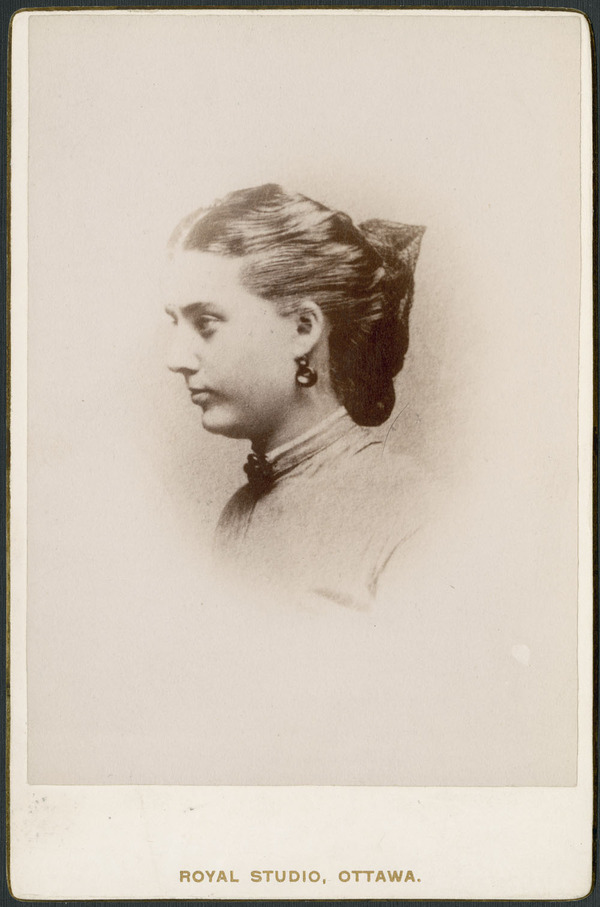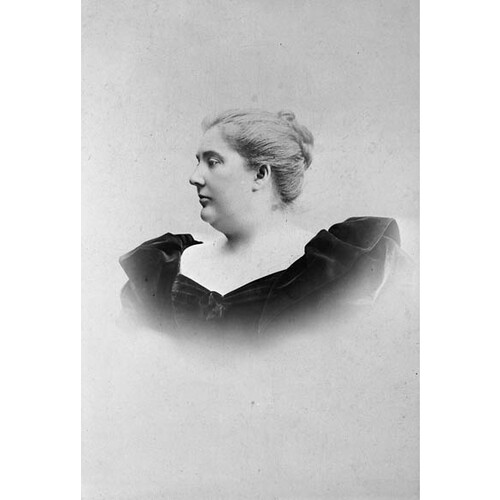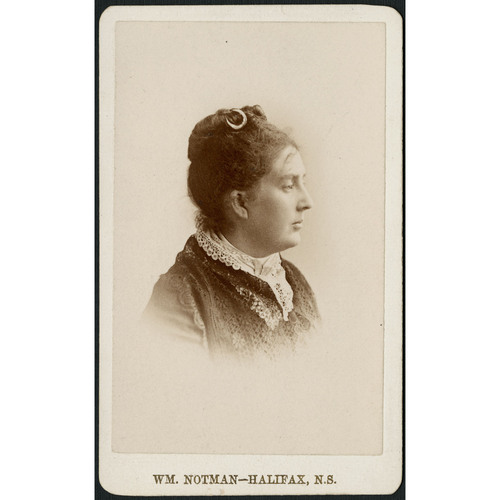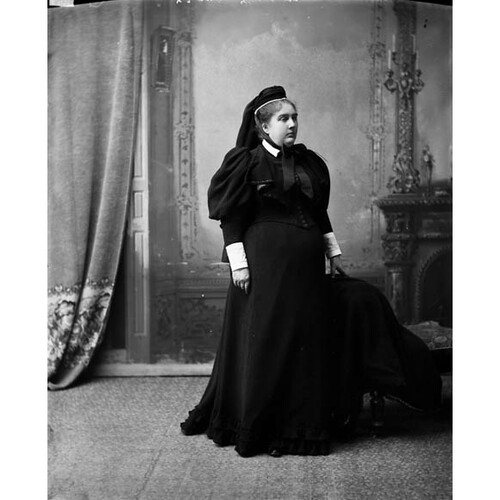AFFLECK, ANNIE EMMA (Thompson, Lady Thompson), home-maker and politician’s wife; b. 26 June 1845 in Halifax, daughter of James Affleck and Catherine Saunders; m. 5 July 1870 John Sparrow David Thompson*; d. 10 April 1913 in Toronto.
James Affleck was a sea captain, who married a Newfoundland girl in Halifax in 1844. They had eight children, of whom Annie Affleck was the eldest. The family were Roman Catholic. As Annie was growing up she probably took on the duties of many older girls, helping her mother look after a large family, especially with her father away so much. He disappeared with his ship at sea in 1870. Annie’s education must have been adequate, for her writing style, as she matured, was forceful and brisk, shot through with marvellous gleams of common sense. There is a distinct possibility that she worked for a time in a Halifax shop, which seems to have created some awkwardness later in Ottawa, people being reluctant at first to call on her.
Since 1867 she had been courted by J. S. D. Thompson, a young Halifax lawyer of great talent and some shyness. He taught her French and his father’s system of shorthand. She kept a diary for the latter half of 1867 in which part of that courtship is described, some of it in her newly learned shorthand. Thompson was a Protestant, of a Methodist family, and they were married by special permission in Portland, Maine, in 1870 at the bishop’s palace. Between 1871 and 1883 Annie had nine children. Her first was born dead after a long and difficult delivery; three died in infancy. But two boys and three girls lived and grew up in what was a remarkably close-knit and happy family.
Annie Thompson was a high-spirited young woman, moody, often a creature of her own impulses, reminding one of Catherine Linton in Emily Brontë’s Wuthering Heights. She had pride and independence. She was unlike her husband, whose worries were buried beneath an appearance of calm and judiciousness. She was tougher than he was and would help to keep him bolstered up. In 1882, when he was concerned about losing a provincial electoral battle in Antigonish, N.S., wondering if she would mind if he lost, she wrote back to say he was to keep up the fight with good heart, but that if he lost she did not care “one row of pins.” “I wish I could be with you for one ten minutes to talk square to you. . . . So keep up your courage . . . win or lose they can’t keep you from me much longer. . . . So now . . . you must not be such an awful baby until you get home and then I’ll see how far you can be indulged.” This letter speaks volumes about Annie’s character, delivering to a nervous, lonely, and much-loved husband determination and cosiness at one and the same time.
A wife like that really made Thompson’s career possible. He went to the Supreme Court of Nova Scotia in 1882 on his own merits, but she was the one who in 1885, when the opportunity arose for her husband to become minister of justice in Ottawa, virtually pushed him out of the house to take it. She thought he should leave that bunch of “those old crows” (her words) on the Nova Scotia bench and get out into a world which would better test and demonstrate his talents. He did not really want to go: she was the one who decided.
The family finally moved to Ottawa in 1888, the year that Annie became Lady Thompson, and they were to live in several rented houses in the vicinity of Metcalfe and Lisgar streets. The entertaining she did was considerable. During the sessions of parliament she gave dinner parties every Monday and Tuesday for mps and their wives, and on Wednesdays she received visitors. She had brought a cook from Halifax, but by the session of 1892 the cook was gone, and, short of money, nursing an invalid daughter (Frances Alice, whom everyone called Frankie), Annie took to the kitchen and personally cooked for the 250 guests who dined at their house that session. After her husband became prime minister in December 1892 her role shifted somewhat, and they acquired two servants. Her recipe for entertaining in Ottawa was succinct: “Feed them, feed them, feed them – nothing else will satisfy them.”
Suddenly, on 12 Dec. 1894, she was left a widow when Thompson died of a heart attack in Windsor Castle at the age of 49. He left a very small estate, and the Lady Thompson Fund was begun that month as a private subscription for Annie and Frankie; it would be supplemented by Canada’s parliament in 1895.
Annie was devastated by Thompson’s death, for they had been close in their 24 years of marriage. Nevertheless, she picked herself up with great courage. Within three days of Sir John’s death she was after his papers in the east block of the Parliament Buildings. She had kept her husband’s letters to her (she had exacted very early the promise that he would write every day he was away) and his letters to their children. This considerable correspondence – some 30 trunks of it – she took with her when she moved to Toronto in 1895.
The move came as no surprise. Setting up a law practice in Toronto in the event of political defeat was an option Sir John had considered. After 1894, with good medical treatment available for Frankie and two sons studying law there, it was a natural place for Annie to go. One woman who helped her find a house was the wife of the governor general, Lady Aberdeen [Marjoribanks*], with whom Annie had worked in supporting the National Council of Women of Canada. Both the Aberdeens had much admired John Thompson. Another friend, Sir Frank Smith*, a Toronto senator, also helped facilitate Annie’s choice of housing. In Toronto she stayed, living finally at 18 1/2 St Joseph Street and becoming a member of nearby St Basil’s Roman Catholic Church. In hospital in 1913 for exploratory surgery, she was discovered to have inoperable cancer and she died on the operating table. Lady Thompson was buried in Mount Hope Cemetery, Toronto.
[Annie Affleck Thompson’s papers are in vol.283 of the Sir John Thompson papers at NA, MG 26, D. His letters to her are vols.288–91, and her diary is in vol.293. Contemporary biographical accounts appear in Types of Canadian women . . . , ed. H. J. Morgan (Toronto, 1903) and in the Toronto Evening Telegram obituary of 11 April 1913. [I. M. Marjoribanks Hamilton-Gordon, Marchioness of] Aberdeen [and Temair], The Canadian journal of Lady Aberdeen, 1893–1898, ed. and intro. J. T. Saywell (Toronto, 1960), and Waite, Man from Halifax, both have a good deal of information about Lady Thompson. Sandra Gwyn, The private capital: ambition and love in the age of Macdonald and Laurier (Toronto, 1984), offers insights but is not as well researched as Heather Robertson, More than a rose: prime ministers, wives and other women (Toronto, 1991). p.b.w.]
Cite This Article
P. B. Waite, “AFFLECK, ANNIE EMMA (Thompson) (Lady Thompson),” in Dictionary of Canadian Biography, vol. 14, University of Toronto/Université Laval, 2003–, accessed March 28, 2025, https://www.biographi.ca/en/bio/affleck_annie_emma_14E.html.
The citation above shows the format for footnotes and endnotes according to the Chicago manual of style (16th edition). Information to be used in other citation formats:
| Permalink: | https://www.biographi.ca/en/bio/affleck_annie_emma_14E.html |
| Author of Article: | P. B. Waite |
| Title of Article: | AFFLECK, ANNIE EMMA (Thompson) (Lady Thompson) |
| Publication Name: | Dictionary of Canadian Biography, vol. 14 |
| Publisher: | University of Toronto/Université Laval |
| Year of revision: | 1998 |
| Access Date: | March 28, 2025 |







